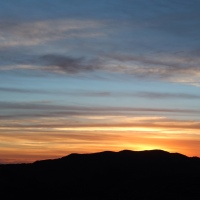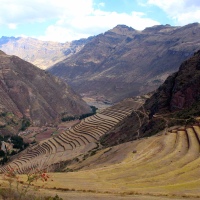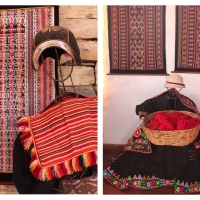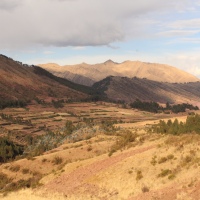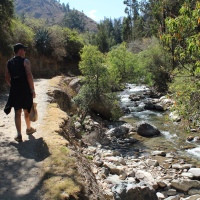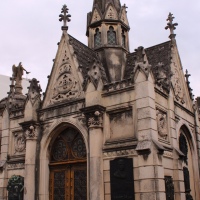We ended our time on Bolivia with a visit to Isla del Sol, the Inca's mythical birth place of the sun and the god Varacocha. It is from here that the first Incas are said to have journeyed to Cusco to found the Inca empire.
The island can be found in Lake Titicaca, the largest high altitude lake in the world. To get there we took a boat from Copacobana, a small town on the eastern edge of the lake.
This was our first time getting up close with a significant Inca site so we were pretty excited. We opted to stay a night on the island to catch the sun set and sun rise, which as you can see above turned out to be a great idea.

Yumani Village, Isla del Sol.
Things got off to a comical start. We stayed at Yumani Village, one of two main drop off points on the island (the other is Cha'llapampa). Our hostel was on a ridge but we hadn't realised how steep the hike up would be…

Old Inca terraces used for agriculture.
At 3,808 metres altitude the hike, with all our bags, had zero appeal. We retreated to a nearby café and tried to work out what to do. Saskia in particular has a hard time with altitude and was a little distressed.
As we waited and took in the view we saw several herds of donkeys being shepherded down the slopes. We found out that the donkeys carry supplies up to the restaurants on the ridge…the answer to our problems! So, we paid six dollars for two donkeys and headed up the ridge with our pack animals in tow.
Isla del Sol features several sets of ruins and minor sites but the two main attractions are arguably the terracing and stairs at Yumani and the Chincana complex to the north. These sites are linked by a picturesque half day walk along the island's ridge line, which we tackled the next day.

The stairs, known as Escalera del Inca,.
We really enjoyed the walk, although the thin air made minor slopes feel like hills! The views are sensational. It actually looks remarkably similar to the Taupo region in New Zealand and Mark had to keep reminding himself that this was a serious Inca site.

A small village on the ridge line.

Looking south towards Copacobana.

Piles of stones. In the background you can see the Andes, which pass on the east.
The big draw for Chilcana is the sacred rock, the site where the sun is meant to have emerged. The site also contains a small ceremonial plaza and dramatic ruins that once housed the priests and caretakers of the rock.
To be completely honest we thought the rock itself was a disappointment. We walked straight past it several times and it was only through deduction that we worked out which one it was. They really need to put signs in there, but regardless we couldn't understand why that piece of the landscape was singled out.

What's the big deal?
Opposite the rock is a small patch of cleared ground with a ceremonial table. Not sure whether the area has been restored but that was slightly more interesting.
The ruins a few metres north were far more interesting. They are a small, labyrinthine complex that provided accommodation and food storage for the priests. Perched on the edge of the hill, they look down onto a tranquil beach and provide a good view of the lake.

Note the wall insets in the left. These are actually very common in Inca architecture and apparently are where religious artefacts would be placed, as well as mummies.
After a bit of a rest here we headed down to Cha'llapampa to catch a boat back to Yumani. It's a nice spot with am interesting museum. Apparently there's an underwater village just north of the island. Not sure how old it is but they've recovered pots etc and put them in the museum. Worth a visit while you wait for the boat.

Kids pretending to go fishing.
One thing we really loved were the boats made out of reeds. They look like old viking boats. The locals on the Peruvian side actually make islands out of the reeds as well as boats. We considered paying them a visit but heard the area has become heavily commercialised, so we skipped it and headed to Cusco instead.
And so ends our trip to Bolivia. We have one more dispatch on Death Road but it will take awhile to pull together (Mark has an hour of footage). All in all we really enjoyed our five weeks in Bolivia. The altitude got the best of us in the end but it was definitely worth the time. If pushed for time make beelines for Rurrenabaque and Sucre, they are great places to stay and offer plenty to do in the region. Don't linger in La Paz, it's not worth it!
The next posts will be a series on the Incas, including trips to ruins, museums and general stuff we learnt. Will mark them all with the 'Inca' tag so that they are easy to pull up for those interested. Looking forward to going back over the material.
As always thanks for reading. We've clocked up over 450 subscribers, which is both flattering and humbling. We get a real buzz looking at which countries our readers are based in, very cool! This blog has exceeded our expectations and we hope everyone else is enjoying this as much as we are.
Kind regards,
Mark and Saskia.








































































